
|
|
Für die deutsche Fassung bitte nach unten scrollen
|
|
The Odyssey of Hercules
|
|
|
Our highlight of the month has achieved international fame. The magnificent bronze bust of Hercules from the world-famous Mariaud de Serres collection was acquired by us in the USA, ended up in Germany, stayed there for a few weeks, and only found its way to Vienna via Paris. Why? You can read about it here.
|
The wonderful shabti of Horiraa also travelled a long way; we discovered it in a Spanish collection. And the charming bronze statuette of a youthful faun with an owl. He came to Vienna from France. Ancient art is in demand all over the world. Therefore, if you cannot come to us, then the gallery will come to you: We guarantee free delivery to you even during these times of restricted travel options – for all objects from this newsletter and for most of the ones on our website!
|
But relaxation is in sight: We have just received information that most probably we will be able to reopen our galleries in Vienna from February 8. So we are looking forward to meeting you again very soon!
|
|
|
|
Our Highlight of the Month:
|
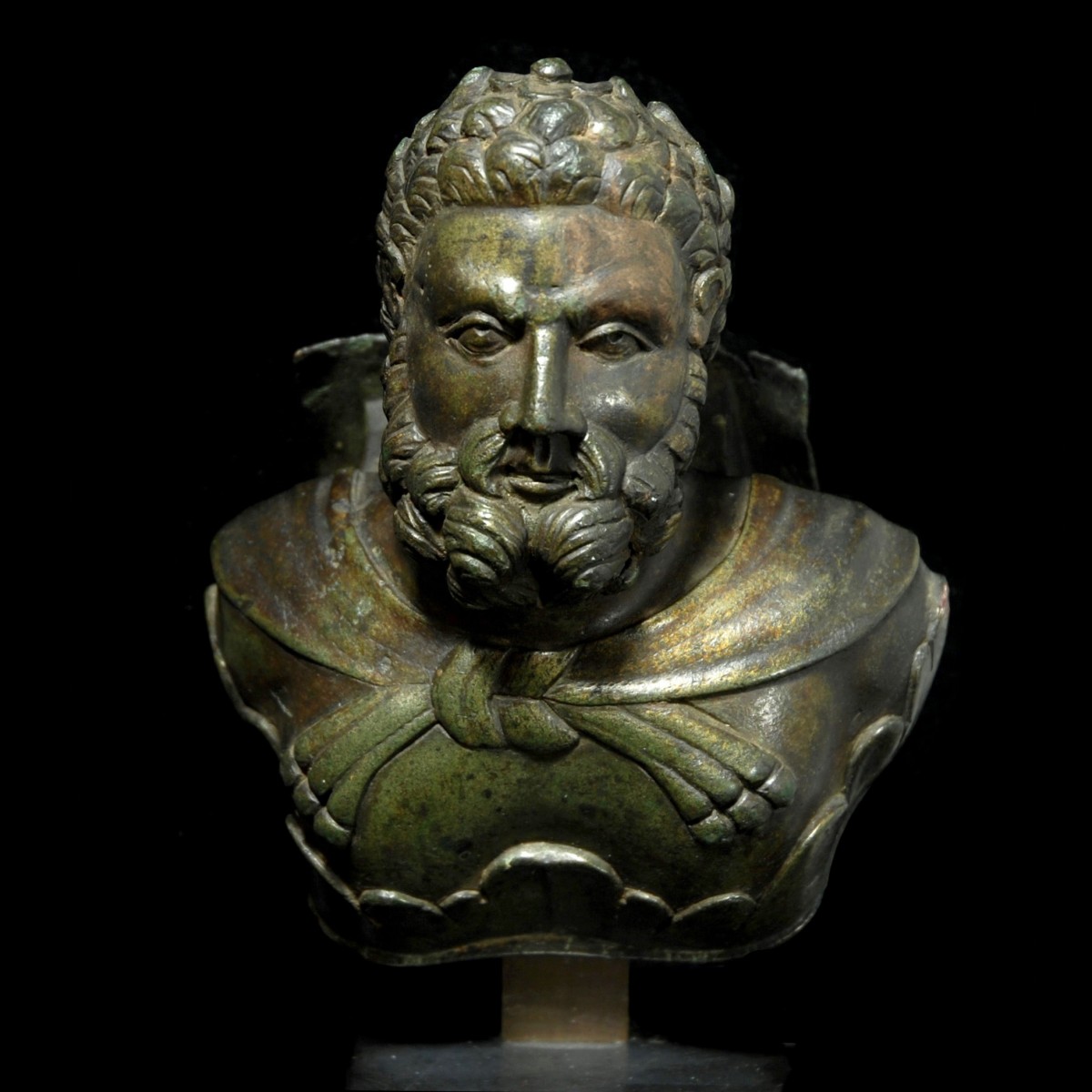
|
|
|
|
|
|
Roman Empire – 2nd century A.D.
|
Large bronze bust of Hercules that once adorned an important Roman traveling chariot. Hercules wears a laurel wreath in his short, curly hair, he has a thick beard with broad shaggy hair. He has tied the fur of the Nemean lion around his shoulders, whose paws cross over the side of the chest. The face is expressively designed, with bulging brows, strong cheekbones and vertical forehead wrinkles that emphasize the tension. The eyes look awake under thick lids, the pupils are perforated. The bust rises from a calyx whose leaves frame it from below. On the back a rectangular, perforated attachment for mounting on the traveling chariot. On a high metal base.
|
Provenance: Collection Mariaud de Serres, acquired prior to 2000. The estate auctioned at Christie's 16/17 February 2011, lot 417. Last in an US private collection.
Dimensions: 14 cm x 12 cm
Price: 24 000 Euro
|
|
|
|
Selected Artworks of the Month:
|
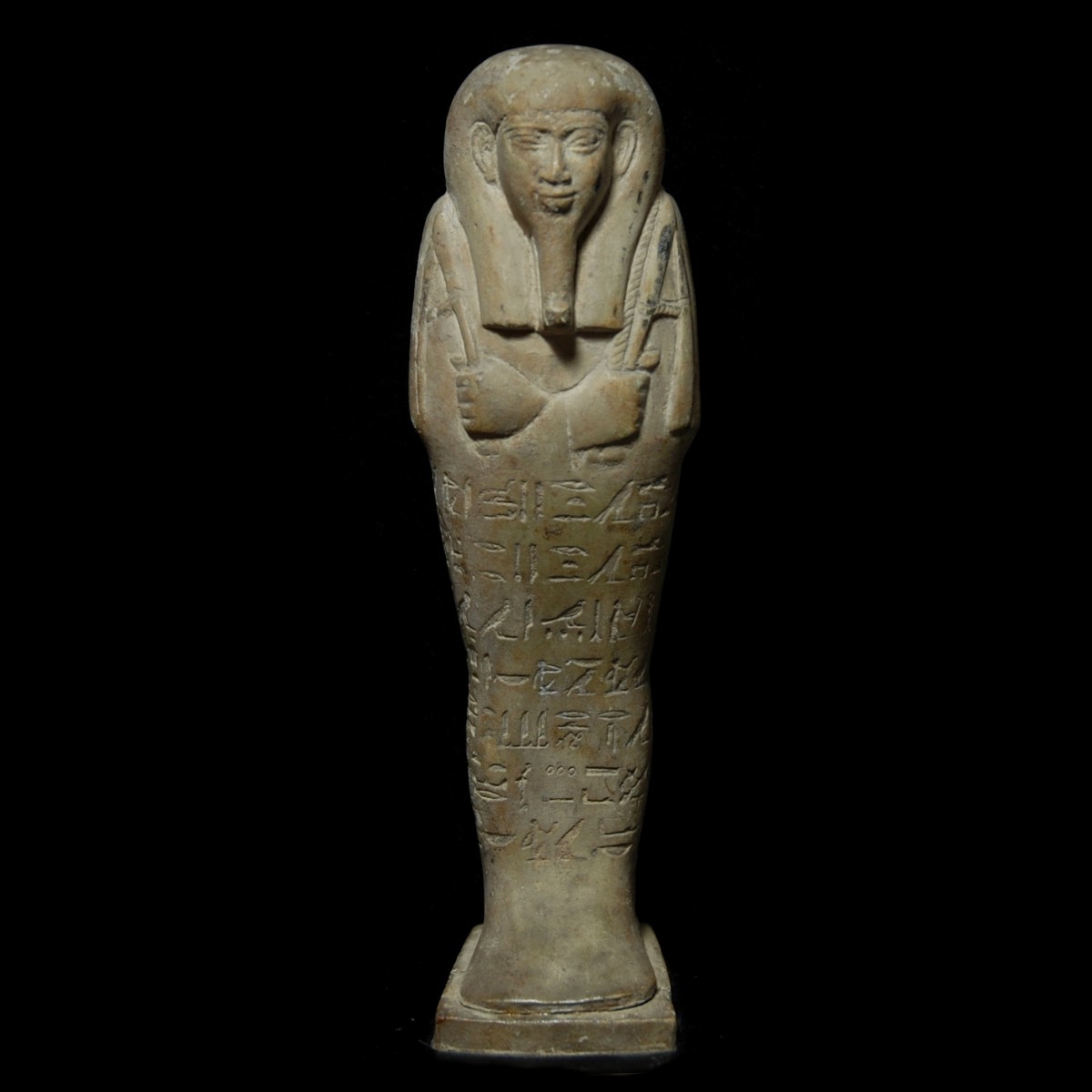
|
|
|
|
|
|
Egypt – Late period, 26th dynasty, Reign of Necho II, 610-595 B.C.
|
Important faience shabti from the tomb of Horiraa, which was uncovered by the German Egyptologist Karl Richard Lepsius in Saqqara in 1830 and whose endowment is kept in the Louvre and the British Museum, among others. The very finely engraved inscription mentions as the owner Horiraa, protocol chief under Pharaoh Necho II and tutor of the later successors Psamtik II and Apries, as well as quarter master of the royal anteroom. With the exception of the back pillar, the inscription is all around. It recites chapter VI from the Book of the Dead. The mummy-shaped figure with fine facial features, the tripartite wig, visible ears, a long false beard rolled up at the end and arms crossed in front of the chest. The figure holds a field hoe in each hand, in the right hand additionally the cord, which fixes the seed basket, which hangs over the left shoulder. The shabti stands on its original plinth. On an old wood base.
|
Provenance: Old French private collection acquired in the 1960s. Thence in the Spanish private collection O.P., Barcelona, Spain. Accompanied by French and Spanish antiquities passports.
Dimensions: 17.4 cm high
Price: 16 000 Euro
|
|
|
|
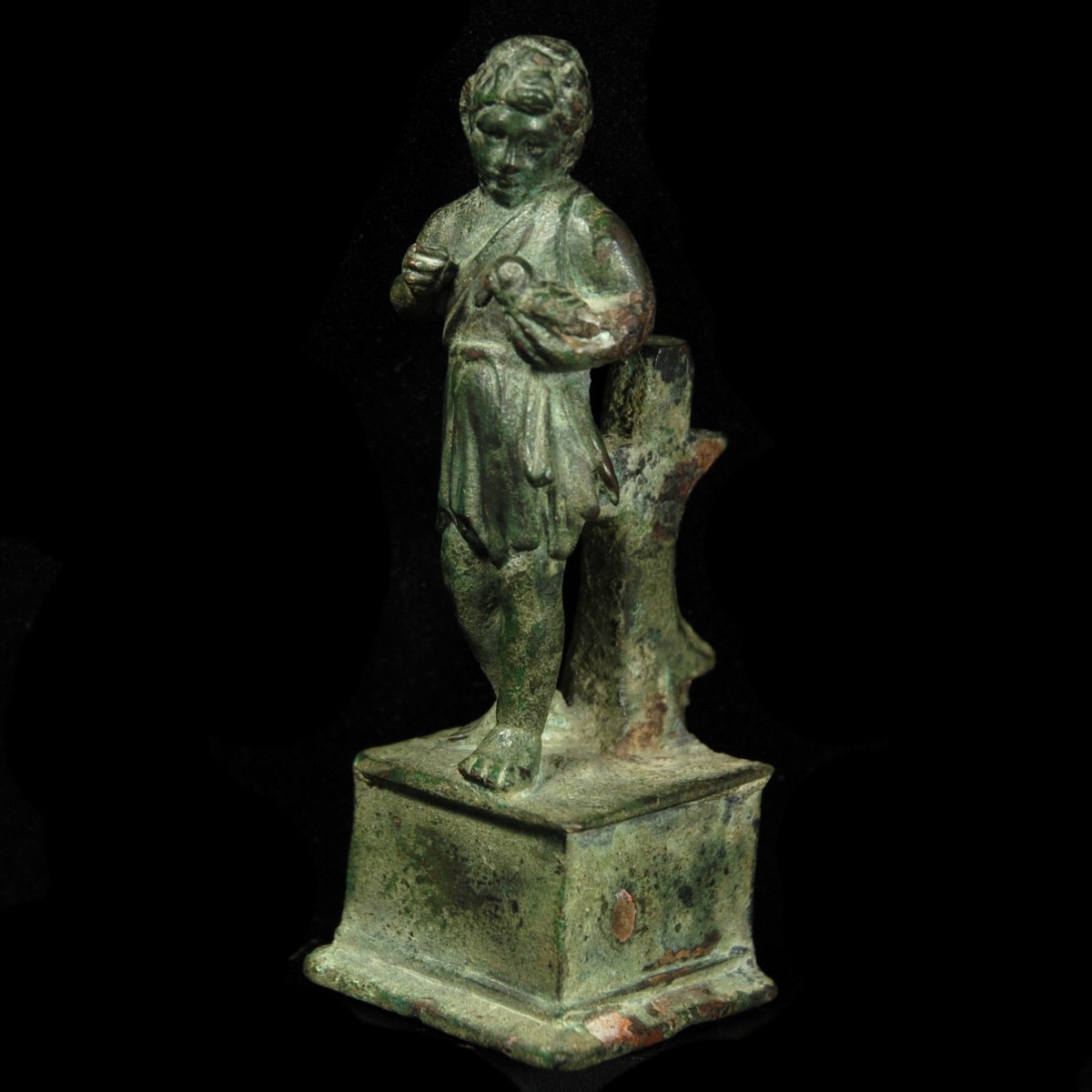
|
|
|
|
Roman Empire– 1st-2nd century A.D.
|
Extremely charming statuette of a youthful faun. The boy with pointed goat ears and thick short curls standing with the weight on his left leg, the right one slightly set back and turned outwards. He wears a short robe knotted on his left shoulder, his right shoulder uncovered. The young faun has lowered his head slightly to the bottom left and looks at a small owl, which he holds at chest height in his left hand. The right hand probably feeds the animal with food. The statuette still stands on its original base which is connected over a bar with a vertical beam, which is cut out semi-circularly at the back. Through this connection, the statuette was mounted as an ornamental object on a furniture or on a carriage.
|
Provenance: French private collection Dr. Pradel, Poitiers, acquired prior to 1970.
Dimensions: 11.7 cm high
Price: 6 000 Euro
|
|
|
|
|
|
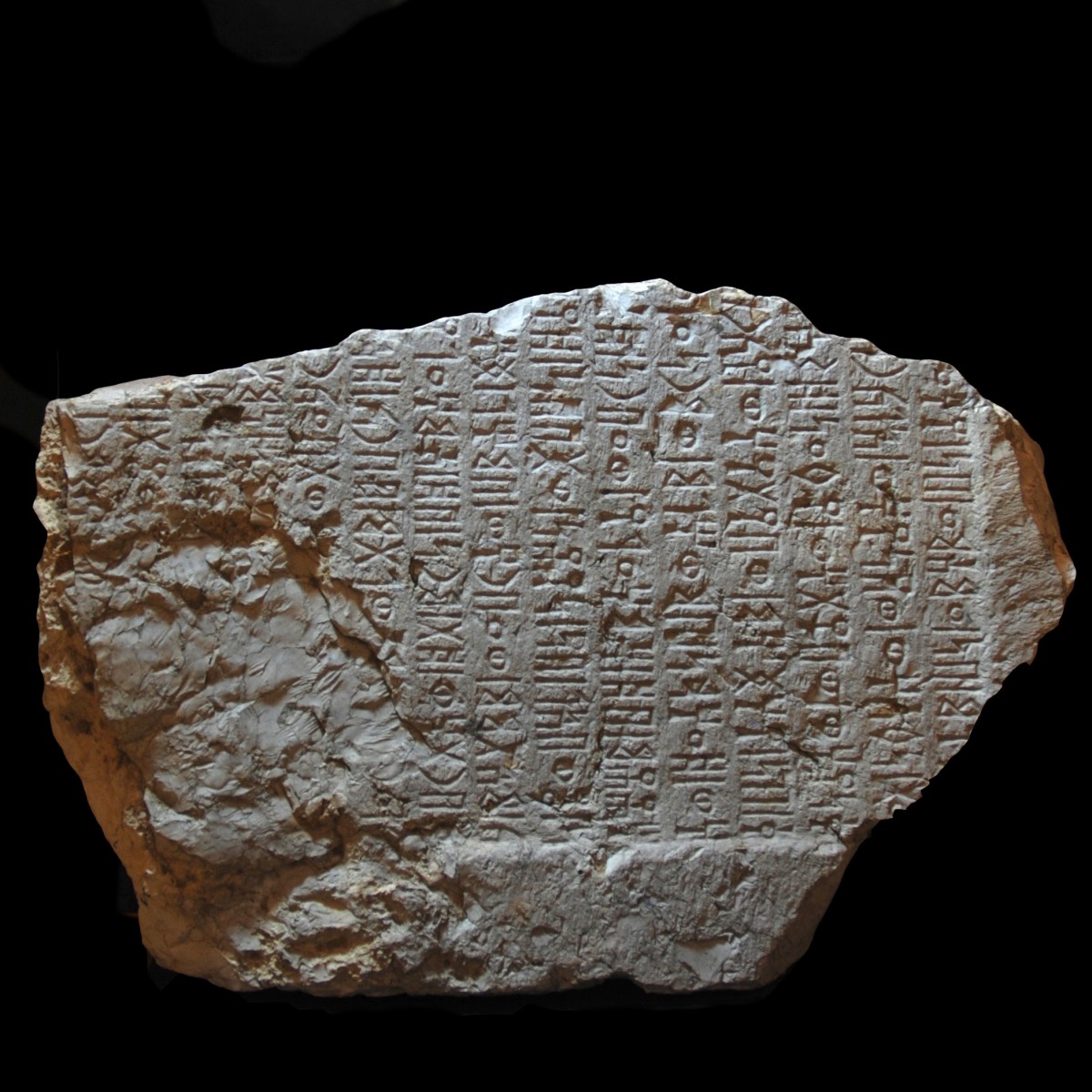
|
|
South Arabia – 4th-3rd century B.C.
|
Large limestone fragment with several lines of inscription dedicated to a deity whose name is not preserved. The dedicatee entrusts the deity with his person, his sons, his goods, his house and a series of irrigation systems. From line 5, the text contains a number of previously unknown terms. From the plateaus north of Sanaa. With scientific assessment.
|
Provenance: From the estate of a honorary consul in Touraine, France. In Europe since at least the 1960s.
Dimensions: 42 cm x 60 cm x 13.5 cm
Price: 12 000 Euro
|
|
|
|

|
|
|
|
|
|
Egypt – Ptolemaic Period, 332-30 B.C.
|
Completely preserved wood statuette of Ptah-Sokar-Osiris. The figure in mummyform is made of two parts and once contained a papyrus roll, possibly the Egyptian Book of the Dead or another afterlife text. The statuette with a long wood tenon is mounted in its ancient, rectangular base, in front god Sokar in form of a falcon as the guardian of the dead. The human head of the figure wears a tripartite wig and a false beard. The face is particularly finely modelled. On the head a perforation where the separately worked out feather crown was inserted. White color remains, especially on the base. A rare type of Ptah-Sokar-Osiris statuette made of two parts.
|
Provenance: French private collection, due to the old screw fitting at least since the 1970s. Accompanied by a French antiquites passport.
Dimensions: 65 cm high
Price: 16 000 Euro
|
|
|
|
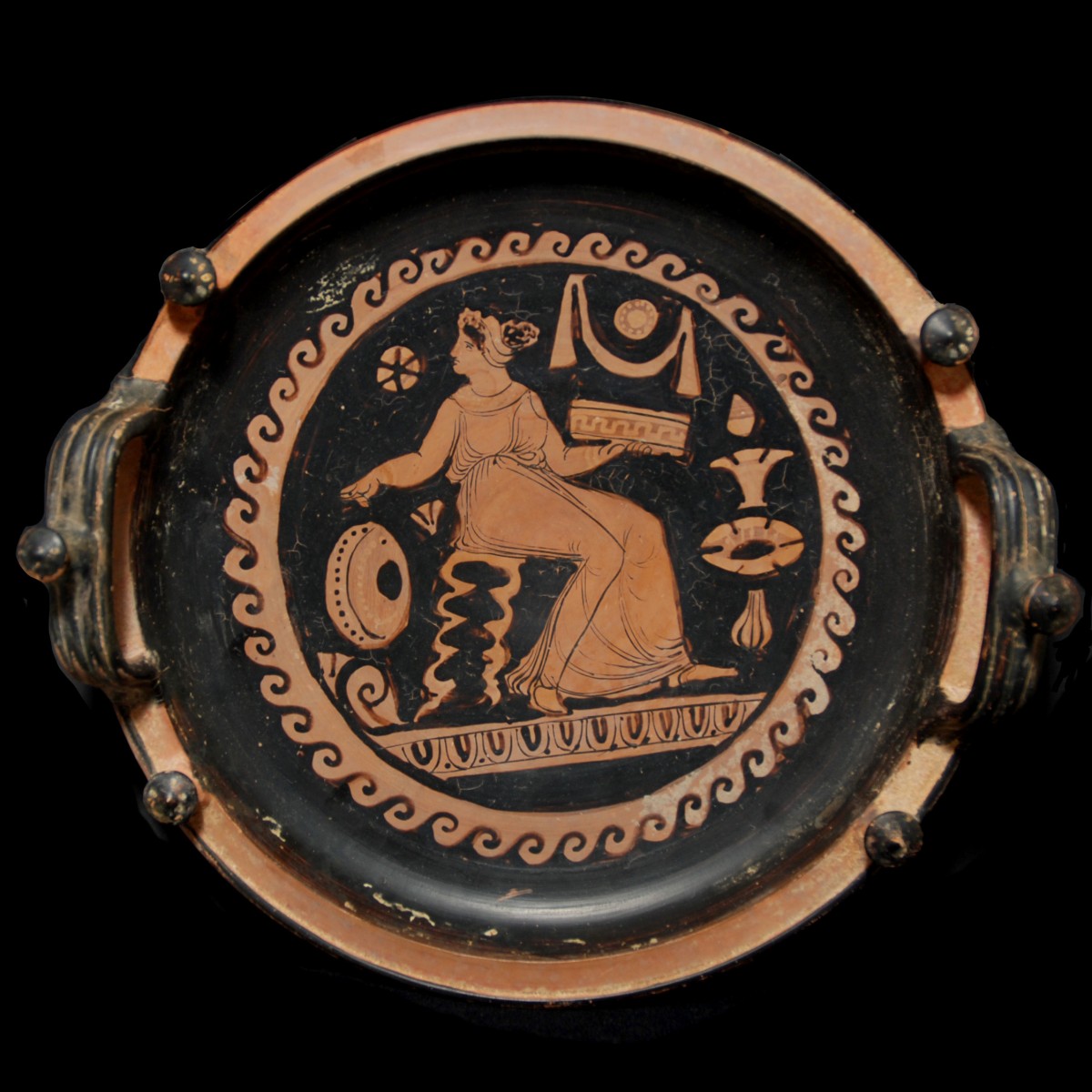
|

|
|
Greece/Apulia – 340-320 B.C.
|
Red-figured knob-handled dish (patera) attributed by Arthur D. Trendall to the Vatican painter 24. The motif in the centre depicts a woman on a rock to the right, who turns her head backwards. She holds a cista in her left hand in front of her body and stretches her right hand backwards. Below a hand drum (tympanum). In the image area also volutes, tainiai and flowers. The scene is lined below by an egg–and-dart pattern and framed by a wavy ribbon. At the bottom, large palmettes and portraits of women to the right (“Lady of Fashion”). Six knob handles with painted flowers on the upper rim. The knob-handled dish was attributed to the Vatican 24 group in a handwritten correspondence by the archaeologist Arthur D. Trendall, the expert in South Italian vase painting, and published in the "Supplements to The Red-figured Vases of Apulia".
|
Provenance: Private collection Frell Albright Houston prior to 1989. On 8 October 1989 auctioned at Hart Galleries, Houston, lot 840. There acquired by Michael Minick, New York. With a copy of the handwritten attribution by A.D. Trendall and a copy of the catalogue page from 1989.
Dimensions: 30 cm in diameter
Price: 8 000 Euro
|
|
|
|
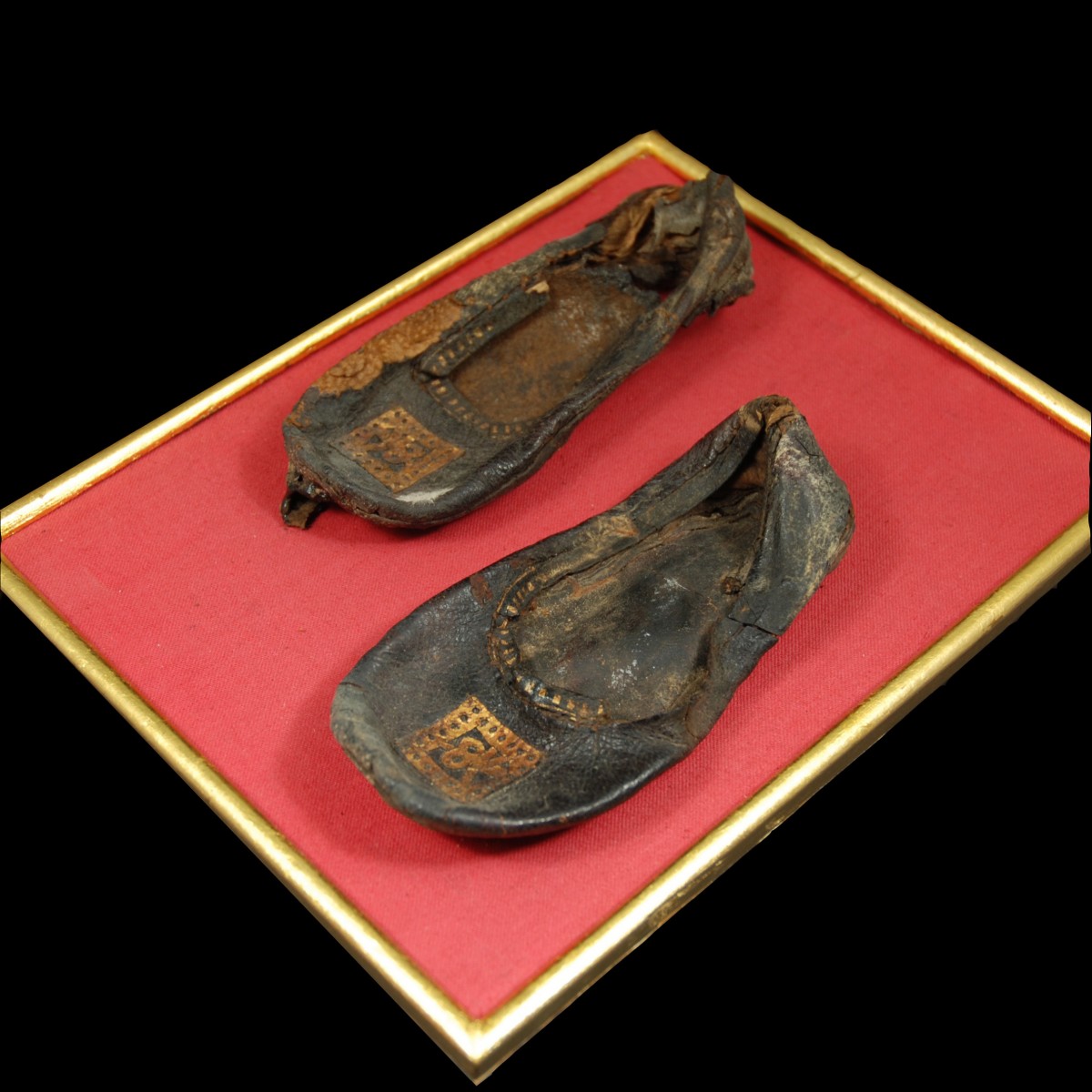
|
|
|
|
|
|
Egypt – 4th-6th century A.D.
|
Finely crafted leather shoes of a child with gold ornaments on them. At the edge, a thin leather strap with gold squares between two thin gold lines pulled around. At the front of the shoe tip is a multi openwork square of gold leaf with a golden loop in the middle. Framed and mounted on a thick cardboard.
|
Provenance: From an old Belgian private collection, acquired in the 1970s.
Dimensions: Shoes 13.5 cm and 14 cm long respectively; 22,5 cm x 17,5 cm (dimensions of the frame)
Price: 2 400 Euro
|
|
|
|
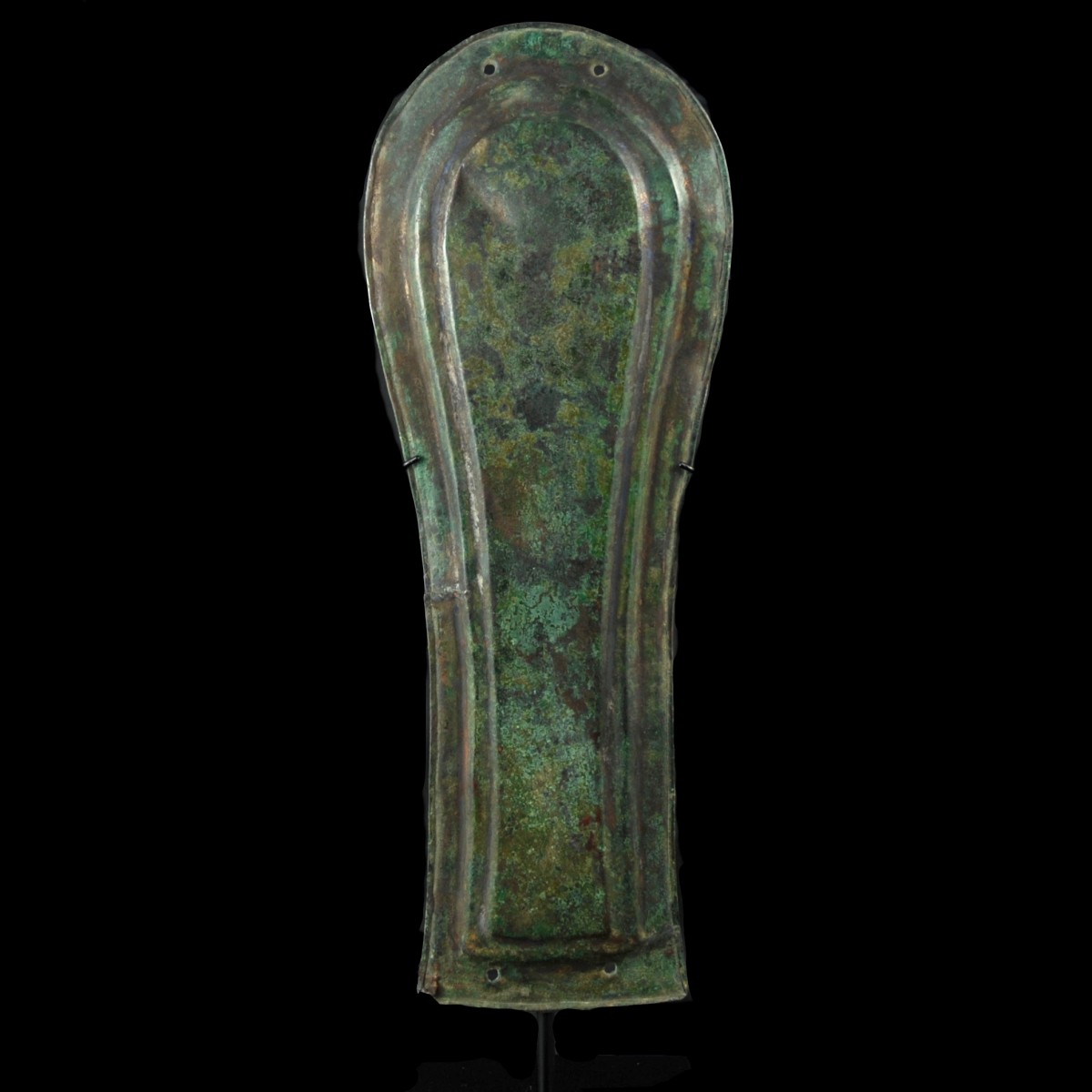
|
|
Assyria – 1st half 1st millennium B.C.
|
Shaffron made of hammered bronze in the shape of a horse's muzzle. The outer area smooth, the edge thickened. Inside, two uniform surfaces hammered of the bronze sheet, which give the horse armor plasticity. Top and bottom perforations to mount the bronze armor on a lining below. A rare example of Near Eastern horse armor. An old collection label from the well known Axel Guttmann collection on the inside. Mounted.
|
Provenance: Private collection Axel Guttmann with the collection number AG R21, acquired 1987 in Frankfurt, Germany. Thence Hermann Historica on 12 April 2010, lot 347.
Dimensions: 32.5 cm high
Price: 1 200 Euro
|
|
|
|
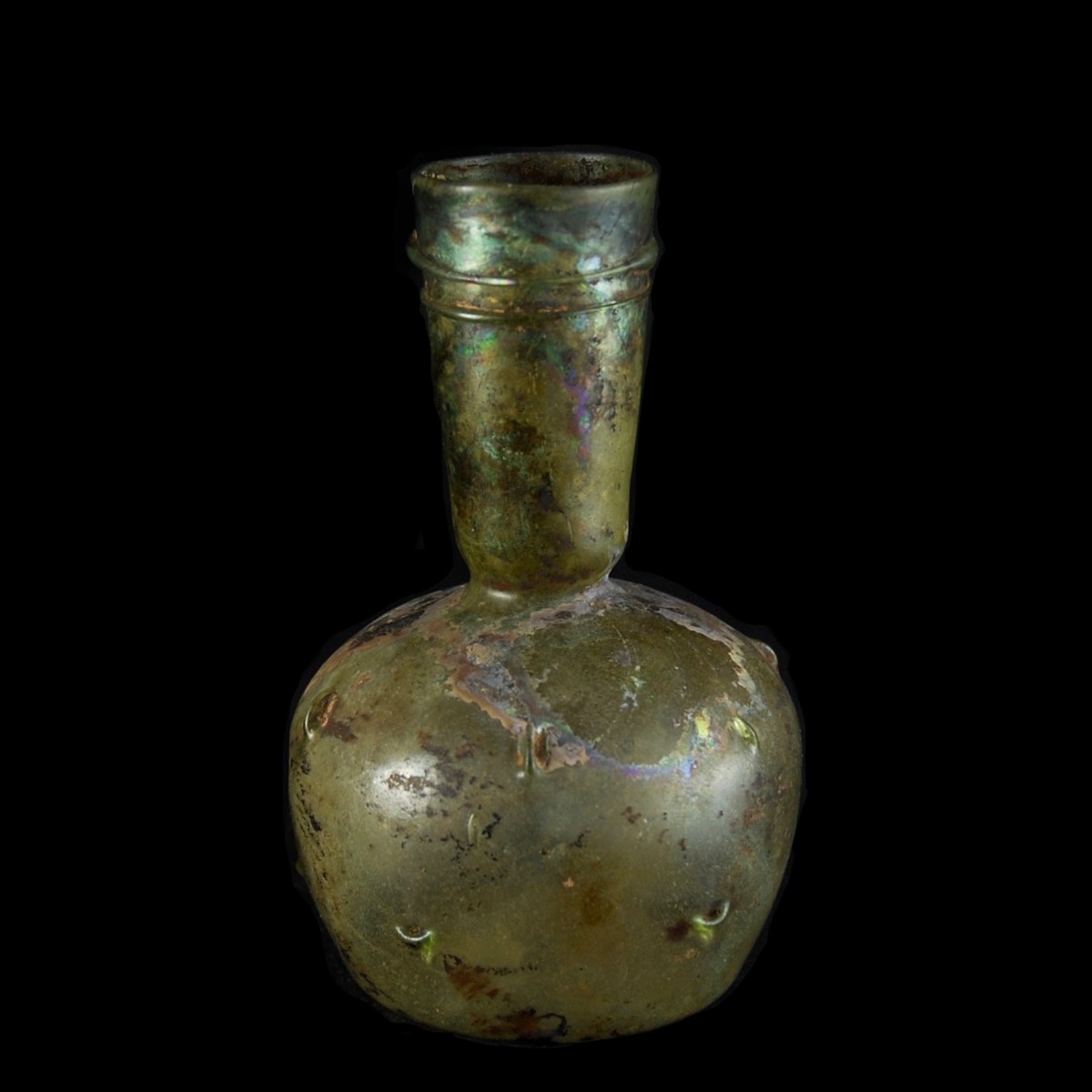
|
|
Roman Empire – 3rd century AD
|
Mouth-blown glass that stands on an inwardly curved base. The neck long and funnel-shaped. Below the muzzle an applied double glass thread. On the shoulder of the round corpus are six vertical ribs pulled out with pliers. Below are another five horizontal ribs.
|
Provenance: Dr. Cornel Winkelmeyer, Essen, Germany. Acquired in the 1970s. Since 2009 with Galerie Antiken Kabinett Gackstätter, Frankfurt, Germany. With confirmation from Cornel Winkelmeyer of 24 September 2009 and a certificate from Galerie Antiken-Kabinett Gackstätter, inventory number 4181.
Dimensions: 12.6 cm high
Price: 1 200 Euro
|
|
|
|
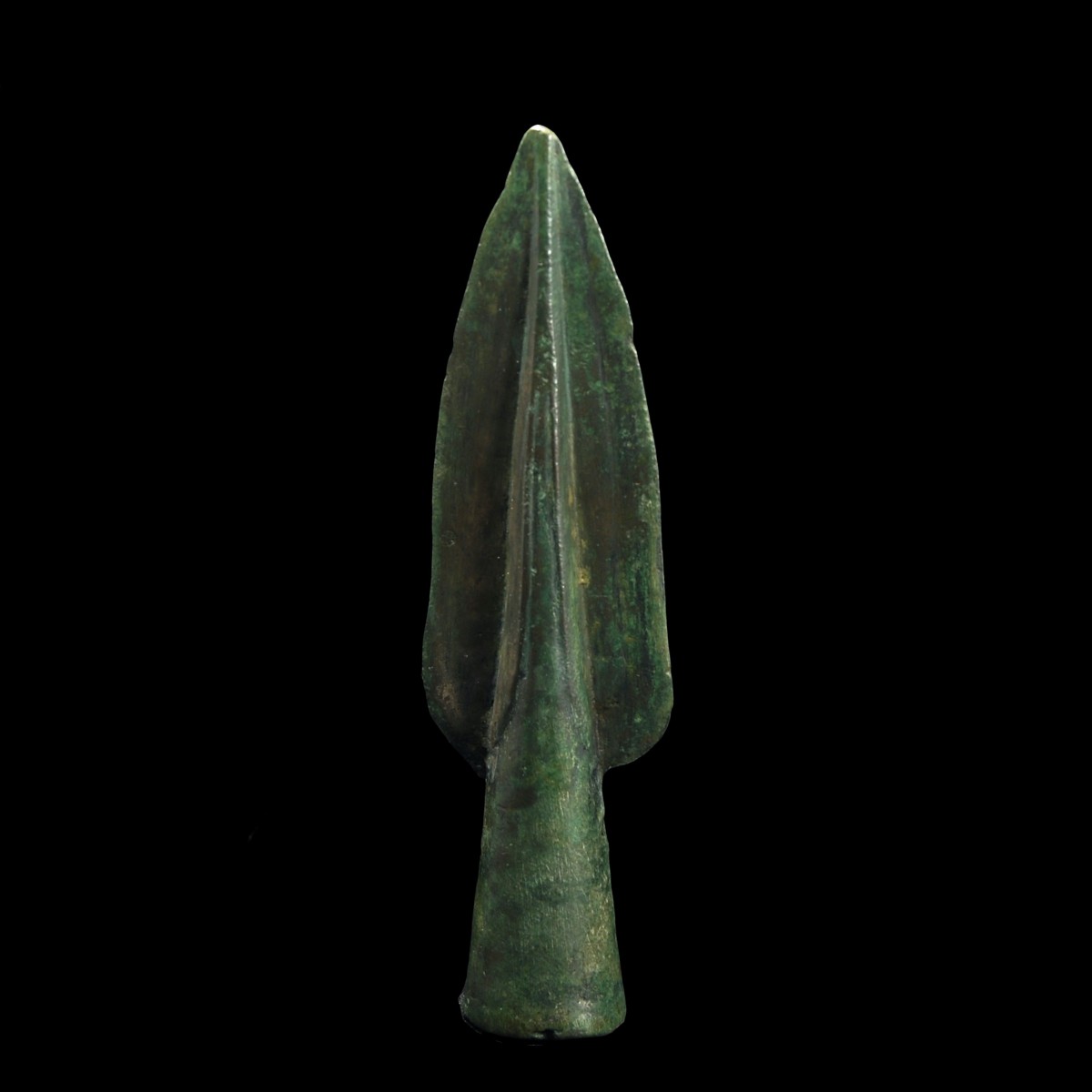
|
|
Middle Europe – 12th-10th century B.C.
|
Spearhead with a profiled spout of Type A. Once a long wood staff was inserted in the spout and fixed through the holes on the sides. A spear was part of a Bronze Age warrior's equipment in Central Europe.
|
Provenance: Ex-collection Kozierowski, Austria.
Dimensions: 14.7 cm long
Price: 900 Euro
|
|
|
|
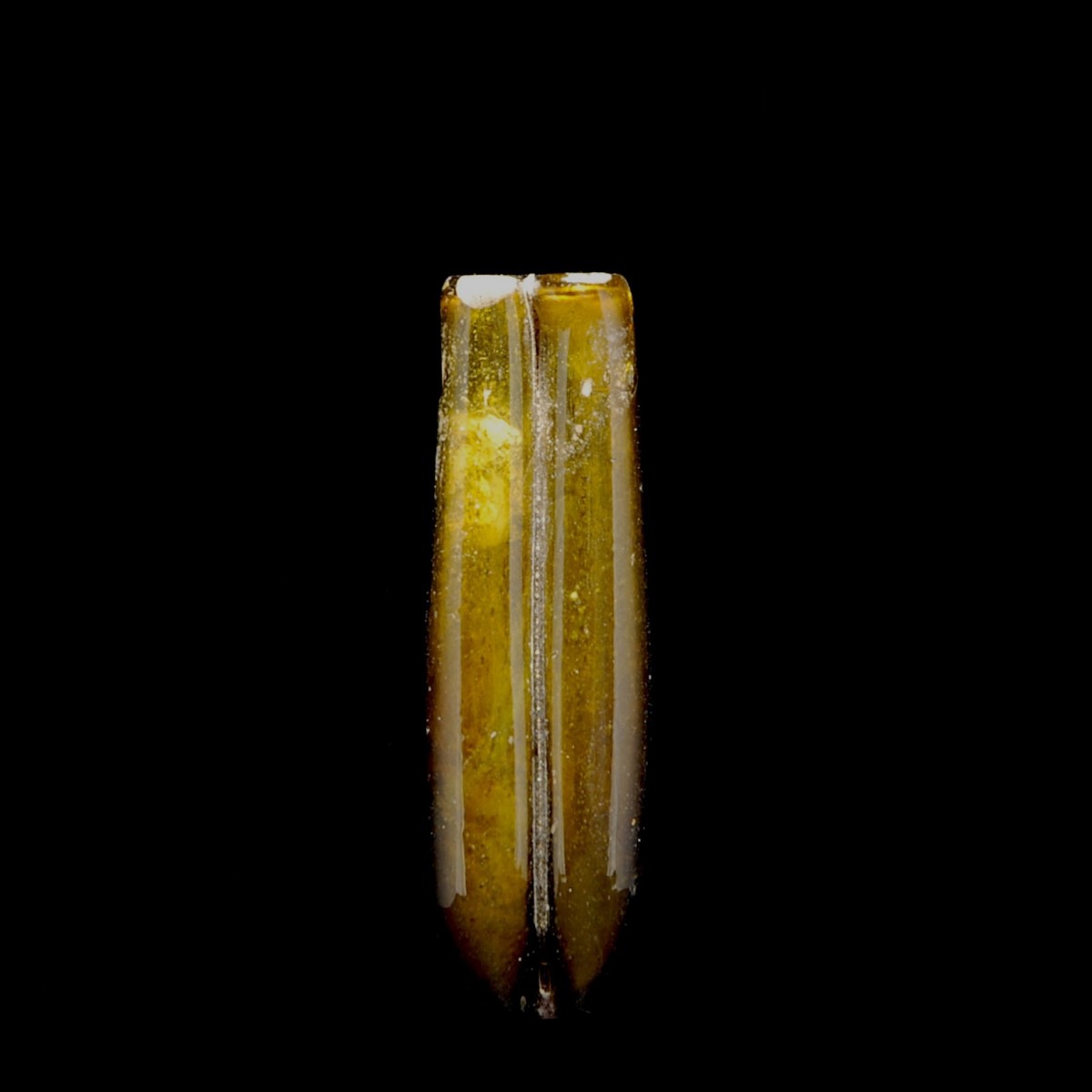
|
|
|
|
Byzantine Empire – 6th-7th century A.D.
|
Double-tube phial-like flask (unguentarium), tapering towards the end, the rim on the spout slightly turned inward. Beautifully shining honey amber color.
|
Provenance: Private collection New York, acquired from Biblical Antiquities, Ltd, 8 King David St. Jerusalem, Israel.
Dimensions: 7.5 cm high
Price: 520 Euro
|
|
|
|
|
|
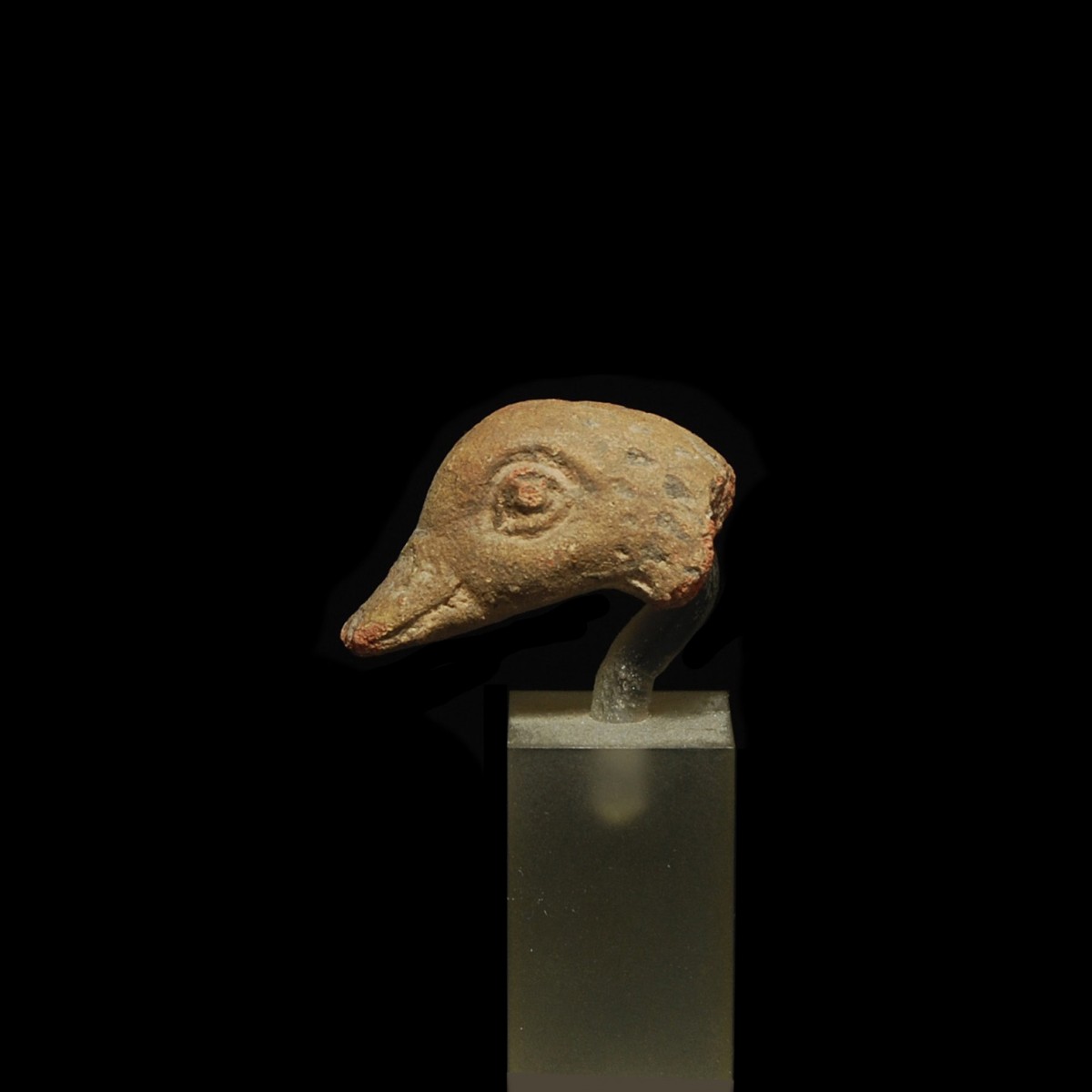
|
|
Roman Empire – 1st century A.D.
|
Small terracotta head of a duck. The closed beak broad and flat, the eyes round with color remains. Plumage on the neck. Possibly from Alexandria.
|
Provenance: Collecton Wolfgang Zoepnek, Dassendorf, Germany.
Dimensions: 3.5 cm long
Price: 280 Euro
|
|
|
|
|
|
|
|
Die Odysee des Herkules
|
Unser Highlight des Monats hat es zu internationaler Berühmtheit gebracht. Die prachtvolle Bronze-Büste des Herkules aus der weltberühmten Sammlung Mariaud de Serres wurde von uns in den USA gekauft, landete in Deutschland, blieb dort einige Wochen und fand erst über Paris ihren Weg nach Wien. Warum? Das können Sie hier nachlesen.
|
Weit gereist ist auch das wunderbare Uschebti des Horiraa, wir haben es in einer spanischen Sammlung entdeckt. Und die bezaubernde Bronze eines jungen Fauns mit Eule. Sie kam aus Frankreich nach Wien. Antike Kunst ist eben in aller Welt gefragt. Daher gilt: Wenn Sie nicht zu uns kommen können, dann kommt die Galerie eben zu Ihnen: Wir garantieren deshalb auch in diesen Zeiten der eingeschränkten Reisemöglichkeiten kostenlose Zustellung zu Ihnen nach Hause – für alle Objekte aus diesem Newsletter und die meisten auf unserer Website!
|
Doch Entspannung ist in Sicht: Gerade erreichen uns Nachrichten, dass wir wohl schon ab 8. Februar unsere Galerien in Wien wieder öffnen dürfen. Wir freuen uns also auf ein baldiges Wiedersehen!
|
|
|
|
Unser Highlight des Monats:
|
|
Römisches Reich – 2. Jahrhundert n. Chr.
|
Große Bronzebüste des Herkules, die einst einen bedeutenden römischen Reisewagen schmückte. Herkules trägt im kurzen, lockigen Haar einen Lorbeerkranz, er hat einen dichten Bart mit breiten Zotteln. Um die Schultern hat er das Fell des Nemäischen Löwen gebunden, dessen Tatzen sich seitlich über der Brust kreuzen. Das Gesicht ausdrucksstark gestaltet, mit wulstigen Brauen, kräftigen Backenknochen und vertikalen Stirnfalten, die die Anspannung verdeutlichen. Die Augen blicken wach unter dicken Lidern hervor, die Pupillen sind gelocht. Die Büste entspringt einem Blütenkelch, dessen Blätter sie von unten einrahmen. Auf der Rückseite ein rechteckiger, gelochter Aufsatz zur Befestigung am Reisewagen. Auf hohem Metallsockel.
|
Provenienz: Sammlung Mariaud de Serres, erworben vor 2000. Versteigert aus dem Nachlass bei Christie’s 16/17 Februar 2011, Los 417. Zuletzt in einer amerikanischen Privatsammlung.
Dimensionen: 14 cm x 12 cm
Preis: 24.000 Euro
|
|
|
|
Ausgewählte Kunstwerke des Monats:
|
|
Ägypten – Spätzeit, 26. Dynastie., Regierungszeit des Necho II., 610-595 v. Chr.
|
Bedeutendes Uschebti aus Fayence aus dem Grab des Horiraa, das vom deutschen Ägyptologen Karl Richard Lepsius 1830 in Sakkara freigelegt wurde und dessen Ausstattung unter anderem im Louvre und im British Museum aufbewahrt wird. Die überaus fein gravierte Inschrift nennt als Besitzer Horiraa, Protokollchef unter Pharao Necho II und Tutor der späteren Nachfolger Psammetich II und Apries sowie Quartiermeister des könliglichen Vorzimmers. Die mit Ausnahme des Rückenpfeilers umlaufende Inschrift rezitiert das Kapitel VI aus dem Totenbuch. Die mumienförmige Gestalt mit feinen Gesichtszügen, dreigeteilter Perücke, sichtbaren Ohren, langem und am Ende eingerolltem falschen Bart und vor der Brust überkreuzten Armen. In den Händen hält die Figur jeweils eine Feldhacke, in der rechten Hand zusätzlich die Schnur, die den Samenkorb („seed basket“) fixiert, der über linken Schulter hängt. Das Uschebti steht auf seiner Original-Plinthe. Einzelne Farbreste noch erhalten. Auf altem Holzsockel.
|
Provenienz: Alte französische Privatsammlung erworben in den 1960er Jahren. Danach in der spanischen Privatsammlung O. P., Barcelona. Mit französischem und spanischem Antikenpass.
Höhe: 17,4 cm
Preis: 16.000 Euro
|
|
|
|
|
Römisches Reich – 1.-2. Jahrhundert n. Chr.
|
Äußerst anmutige Statuette eines jugendlichen Fauns. Der Knabe mit spitzen Ziegenohren und dichten kurzen Locken, steht mit dem Gewicht auf seinem linken Bein, das rechte leicht zurückgestellt und nach außen gedreht. Er trägt ein kurzes Gewand, das auf seiner linken Schulter verknotet ist, die rechte Schulter unbedeckt. Der junge Faun hat den Kopf leicht nach links unten gesenkt und blickt auf eine kleine Eule, die er in Brusthöhe in seiner linken Hand hält. Die rechte Hand reicht dem Tier wohl gerade Futter. Die Statuette steht noch auf ihrer Original-Basis, die über einen Steg mit einem senkrechten Balken verbunden ist, der hinten halbkreisförmig ausgeschnitten ist. Über diese Verbindung war die Statuette als Ziergegenstand auf ein Möbel oder auf einem Wagen montiert.
|
Provenienz: Französische Privatsammlung Dr. Pradel, Poitiers, erworben vor 1970.
Höhe: 11,7 cm
Preis: 6.000 Euro
|
|
|
|
|
Südarabien – 4.-3. Jahrhundert v. Chr.
|
Großes Kalksteinfragment mit einer mehrzeiligen Inschrift, die einer Gottheit gewidmet ist, deren Name nicht erhalten ist. Der Widmungsträger vertraut darin der Göttlichkeit seine Person, seine Söhne, seine Güter, seine Häuser und eine Reihe von Bewässerungssystemen an. Ab Zeile 5 enthält der Text eine ganze Reihe bisher unbekannter Begriffe. Aus den Hochebenen nördlich von Sanaa. Mit wissenschaftlicher Begutachtung.
|
Provenienz: Aus dem Besitz eines Honorarkonsuls in Touraine, Frankreich. Seit mindestens den 1960er Jahren in Europa.
Dimensionen: 42 cm x 60 cm x 13,5 cm
Preis: 12.000 Euro
|
|
|
|
|
Ägypten – Ptolemäische Zeit, 332-30 v. Chr.
|
Komplett erhaltene Holz-Statuette eines Ptah-Sokar-Osiris. Die mumienförmige Figur aus zwei Teilen enthielt einst eine Papyrusrolle, möglicherweise das ägyptische Totenbuch oder einen anderen Jenseitstext. Sie steckt über einen langen Holzzapfen in ihrer antiken, rechteckigen Basis, davor der Gott Sokar in Form eines Falken als Wächter der Toten. Der menschliche Kopf der Figur trägt die dreiteilige Perücke und einen falschen Bart. Das Gesicht ist besonders fein modelliert. Am Kopf eine Lochung in der die separat gearbeitete Federkrone steckte. Weiße Farbreste vor allem an der Basis. Ein seltener Typus einer Ptah-Sokar-Osiris Statuette aus zwei Teilen.
|
Provenienz: Französische Privatsammlung, aufgrund der alten Verschraubung zumindest 1970er Jahre. Mit französischem Antikenpass.
Höhe: 65 cm
Preis: 16.000 Euro
|
|
|
|
|
Griechenland – Mittleres Reich, 2040-1648 v. Chr.
|
Rotfigurige Knopfhenkelschale (Patera), die von Arthur D. Trendall dem Maler des Vatikan 24 zugewiesen wurde. Das Motiv im Inneren zeigt eine auf einem Felsen Frau nach rechts, die den Kopf nach hinten wendet. Sie hält eine Cista in der linken Hand vor den Körper und streckt die rechte Hand nach hinten. Darunter eine Handtrommel (Tympanon). In der Bildfläche noch Voluten, Tänien und Blüten. Die Szene wird unten von einem Eierstabmuster begrenzt und von einem Wellenband gerahmt. Auf der Unterseite große Palmetten und Frauenporträts nach rechts („Lady of Fashion“). Am Rand oben sechs Knopfhenkel mit aufgemalten Blüten. Die Knopfhenkelschale wurde vom Archäologen Arthur D. Trendall, dem Experten für unteritalische Vasenmalerei, in handschriftlicher Korrespondenz der Gruppe Vatikan 24 zugewiesen und in den „Supplements to The Red-figured Vases of Apulia“ veröffentlicht.
|
Provenienz: Privatsammlung Frell Albright Houston vor 1989. Am 8. Oktober 1989 versteigert bei Hart Galleries, Houston, Los 840. Dort erworben von Michael Minick, New York. Mit einer Kopie der handschriftlichen Zuweisung durch A. D. Trendall und einer Kopie der Katalogseite von 1989.
Durchmesser: 30 cm
Preis: 8.000 Euro
|
|
|
|
|
Ägypten – 4.-6. Jahrhundert n. Chr.
|
Fein gearbeitete Lederschuhe eines Kindes mit aufgelegter Goldornamentik. Am Rand umlaufend ein dünnes Lederband mit Gold-Quadraten zwischen zwei umlaufend gezogenen, dünnen Goldlinien. Vorne an der Schuhespitze ein mehrfach durchbrochenes Quadrat aus Blattgold mit einer goldenen Schlaufe in der Mitte. Gerahmt und auf dicker Kartonplatte montiert.
|
Provenienz: Aus alter belgischer Privatsammlung, erworben 1970er Jahre.
Dimensionen: Länge Schuhe 13,5 cm bzw. 14 cm; Dimensionen Rahmen 22,5 cm x 17,5 cm
Preis: 2.400 Euro
|
|
|
|
Assyrien – 1. Hälfte 1. Jahrtausend v. Chr.
|
Aus Bronze gehämmerte Rossstirn in der Form eines Pferdekopfes. Der äußere Bereich glatt, der Rand verdickt. Innen zwei aus dem Bronzeblech herausgeschlagene, gleichförmige Flächen, die der Rossstirn Plastizität verleihen. Oben und unten Lochungen, über die die Bronze-Panzerung an einem darunterliegenden Futter montiert war. Ein seltenes Beispiel altorientalischer Pferde-Panzerung. Ein altes Sammlungsetikett der berühmten Sammlung Axel Guttmann auf der Innenseite. Gesockelt.
|
Provenienz: Privatsammlung Axel Guttmann mit der Sammlungsnummer AG R21, erworben 1987 in Frankfurt. Danach Hermann Historica am 12. April 2010, Los 347.
Höhe: 32,5 cm
Preis: 1.200 Euro
|
|
|
|
|
Römisches Reich – 3. Jahrhundert n. Chr.
|
Mundgeblasenes Glas, das auf einem nach innen gewölbten Boden steht. Der Hals lang und trichterförmig. Unterhalb der Mündung ein aufgelegter, doppelter Glasfaden. Auf der Schulter des runden Korpus sind sechs senkrechte Zwicken mit der Zange herausgearbeitet. Darunter sind noch einmal fünf waagrechte Zwicken.
|
Provenienz: Sammlung Dr. Cornel Winkelmeyer, Essen. Erworben in den 1970er Jahren. Seit 2009 Galerie Antiken-Kabinett Gackstätter, Frankfurt. Mit Bestätigung von Cornel Winkelmeyer vom 24. September 2009 und Zertifikat der Galerie Antiken-Kabinett Gackstätter, Inventarnummer 4181.
Höhe: 12,6 cm
Preis: 1.200 Euro
|
|
|
|
|
Mitteleuropa – 12.-10. Jahrhundert v. Chr.
|
Tüllenlanzenspitze mit profilierter Tülle der Grundform A. In die Tülle war einst ein langes Holz eingesteckt und über die seitlichen Löcher fixiert. Diese Wurflanze gehörte zur Ausstattung des bronzezeitlichen Kriegers in Mitteleuropa.
|
Provenienz: Österreichische Sammlung Kozierowski.
Länge: 14,7 cm
Preis: 900 Euro
|
|
|
|
|
Byzantinisches Reich – 6.-7. Jahrhundert n. Chr.
|
Zweiröhrige ampullenartige Flasche (Unguentarium), nach unten spitz zulaufend, die Lippe am Ausguss leicht nach innen gewandt. Wunderbar leuchtende Honig-Bernsteinfarbe.
|
Provenienz: Privatsammlung New York, erworben von Biblical Antiquities, Ltd, 8 King David St. Jerusalem, Israel.
Höhe: 7,5 cm
Preis: 520 Euro
|
|
|
|
|
Römisches Reich – 1. Jahrhundert n. Chr.
|
Kleines Terrakotta-Köpfchen einer Ente. Der geschlossene Schnabel breit und flach, die Augen rund mit Farbresten. Gefieder am Hals. Wohl aus Alexandria.
|
Provenienz: Sammlung Wolfgang Zoepnek, Dassendorf, Deutschland.
Länge: 3,5 cm
Preis: 280 Euro
|
|
|
|
|
|
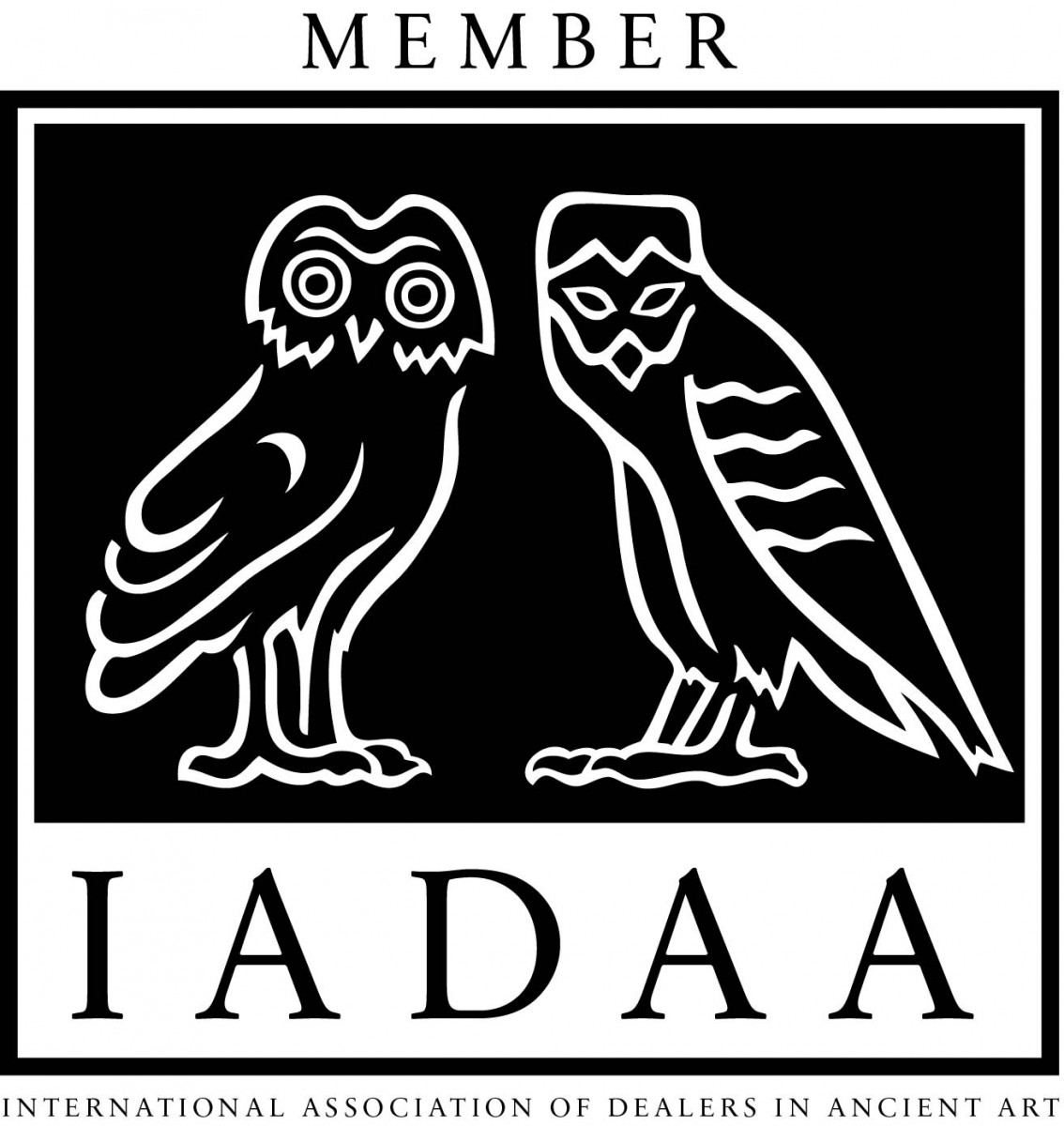
|
|
|
|